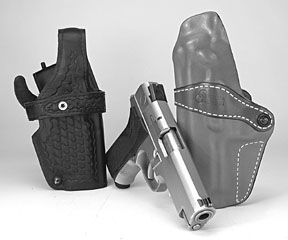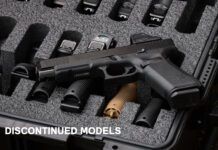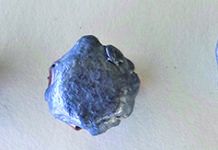
One of the alternatives to the high cost of a new pistol is to buy used. In lieu of finding a creampuff that was only fired by a little old lady on Sundays, one source of used pistols is the police trade-in market. Through firms like Interstate Arms (978-667-7060), pistols formerly owned by active law-enforcement personnel are available to dealers at a wholesale price. The catch for the typical consumer is that a dealer, i.e. an FFL holder, must arrange for transfer. This also means that retail price can vary according to fees, typically 10 to 15 percent of the gun’s cost with a $25 minimum. The prices we list are a dealer’s cash price, or the prices we paid to get the guns without FFL fees.
Keep in mind, however, that not every dealer is willing to go through the hassle of ordering a gun of unpredictable condition which may result in you rejecting it, which can cost return shipping charges and possibly a re-stocking fee. Be that as it may, we decided to order four .40 S&W pistols that have been commonly found in uniformed service. They were the Ruger KP94DAO, the Glock Model 22, Smith & Wesson’s Model 4046, and the SIGArms P229.
We felt buying these guns was a calculated risk. We were able to ascertain their age by checking the serial numbers with the manufacturers. New, each pistol was good enough to be chosen for police departments nationwide. But why were they traded in? Did the design of these pistols become outdated or were they beginning to show their age with more evidence than mere holster wear? Let’s look under the hood and take them for a ride.
[PDFCAP(1)]
One of the nice things about buying police trade-ins is that they usually come with some sort of upgrade. All four of our pistols arrived with night-sights and sometimes you can even get pre-ban higher-capacity magazines. Such was the case with our Ruger KP94DAO. Due to the size of the .40 S&W case, “hi-cap” only meant one extra round. Our Ruger was manufactured in October 1994, and we wondered if it would be smart to buy fresh magazines or at least change out the springs and followers. While the Ruger did not malfunction in any way, we believe that fresh magazines or magazine components are always a plus when depending on a used gun.
There is sometimes confusion as to model designation on this pistol. The slide reads simply P94DAO. But the catalog designation for this pistol includes a K, which indicates a stainless-steel slide. The frame is a matte-finished alloy. In terms of action this model subscribes to the anti-liability theory that a long trigger pull is an effective safety against accidental discharge. Indeed, we found that we had to press the hinged double-action-only (DAO) trigger a long way before ignition. This type of trigger was also found on our Smith & Wesson 4046 pistol. If you can maintain the sight picture throughout the longer trigger press then you can shoot a DAO pistol like these two with accuracy. But we found both the KP94DAO and the Smith & Wesson 4046 very difficult to shoot quickly. While familiarity with equipment may be the ultimate factor in making any firearm viable, today’s trend is towards shorter-action triggers with additional passive and mechanical safeties.
New, the KP94DAO was the least expensive of our test pistols, and Ruger pistols are a popular choice for the rookie starting out with limited funds. While lower-end pistols often suffer first from a lack of reliability, it is our opinion that trademarks of the Ruger P-series are durability and reliable fire. Accuracy from the bench for the Ruger was in the 3.5-inch range at 25 yards. This is what is often described as “combat accuracy” that old-timers like to define by a rule of thumb wherein you must be able to cover the group with your hand. A test of the KP 95 (9mm) in the May 2002 issue of GT showed better accuracy, ranging on average from 2.2 to 3.5 inches at 25 yards. We credit the difference in accuracy to being able to fire the KP 95 single action, plus having less recoil to deal with using the 9mm round. The shorter SA stroke makes it easier to maintain the sight picture because a long DAO trigger can tempt you to change your grip as the trigger is pulled back.
But the difference in firepower between the 9mm Ruger previously tested and our .40 S&W KP94DAO model was significant. In fact, the .40 S&W caliber Ruger pistol produced the most velocity and power among our test pistols, as the accompanying chronograph results show.
The Cor-Bon ammunition was the hottest, but not without signs of dangerous pressure on the horizon. In all but the SIG P229, the Cor-Bon ammunition produced enough pressure to deform or “flow” the surface of the primer cap. This is recognized by a brass-colored circular rupture around the point of the impact left by the tip of the firing pin. The primer cap is formed from brass but plated (in most cases) to appear silver. The Glock 22, being a striker-fired pistol, leaves a different mark on the primer but it too left signs of primer flow when firing the Cor-Bon ammunition. One major concern is debris from degradation of the primer surface entering the firing pin channel and causing it to lock up. While there can be other contributing factors, clues such as higher velocity combined with the highest degree of primer flow led us to believe that the chamber of our Ruger pistol was considerably tighter than that of our other three pistols. People tend to think of matching a pistol to specific ammunition to achieve the best accuracy, but safety and durability are also of concern, especially in a used pistol.
[PDFCAP(2)]So, how do we judge this model as a used gun? Even though we found lint inside the gun and some wear on the grip, we feel this is still one rugged piece of equipment. There is no way of telling how many rounds have been through this gun, but one sign of acceptable wear was that the magazine releases (plural, they’re ambidextrous) were no longer painfully stubborn to operate, a characteristic for which these pistols were renowned.
In terms of design this gun may be a little behind the times, but we felt that this used pistol was still potent and mechanically sound. Though we feel this pistol or its Traditional Double Action brethren is a good buy for self-defense, the $340 price tag is a little high. The basic KP94DAO new is only $575 (MSRP). Add at least $25 to $50 to the wholesale price and subtract at least that amount for actual retail price, and the difference in price between a new gun and a nine-year-old gun shrinks considerably.
[PDFCAP(3)]
It could be said that the 4046, just like the Ruger KP94DAO, belongs to a bygone era. Our 4046, although fully functional with night sights and eleven-round magazines, showed the most visual wear. Indeed, having left the factory in 1992 it was our oldest pistol. But to its credit the frame-to-slide fit was tight, and the gun was ready to go. Picking the gun up, its 42 ounces of weight—the heaviest in our test—was immediately apparent. The upside was the Smith & Wesson pistol transmitted the least amount of recoil, in our judgment.
The magazine release is checkered, easy to find and out of the way until needed. It has low-mount night sights, a design which was not found on too many pistols in 1992. Being DAO, the only control protruding from the pistol’s side is the slide release, making it snag-free. Its plastic grip wraps around from the rear and offers checkering on the sides and backstraps that blend cleanly into the beavertails. The front strap is checkered, as is the front of the trigger guard for those who use their weak side index finger to hold on to this point. Other forward-thinking features for this time period include a flare at the bottom of the front strap and an undercut behind the trigger guard to lower the boreline in relation to the grip. Slide-to-frame contact runs the entire 6.2-inch length of the frame. The rear sight could have been moved back another 0.3 inches for additional sight radius but this pistol started life as a decocker model. The rear sight is dovetailed into the slide ahead of where the decocking machinery for the TDA (traditional double-action) had been housed. The circular plates on either side of the slide cover the place where the safety and decocking levers were mounted. (The Ruger pistol also displays this characteristic.)
In firing our two DAO pistols, the Ruger and the Smith & Wesson 4046, our bench technique consisted of a multi-step process. We began with a coarse sight picture, instituting a gross take-up of slack in the trigger, then confirming a fine sight picture and holding it throughout a final controlled press. Hammering the trigger at close quarter targets required a consistent grip to avoid dipping the muzzle or letting off shots too quickly. With proper technique we were rewarded with satisfying strings of continuous fire. Our groups averaged approximately 3.2 inches for all shots fired. However, our 4046 was the only pistol in the test to malfunction. Twice the gun failed to go fully into battery. This happened from a rest where one staff member observed that the slide had brushed up against the support, hindering a full cycle. If this were not the cause of the malfunction our next best guess would be to replace the recoil spring.
In fact, this is one point that should be reviewed on any used semi-automatic pistol and considered regular preventive maintenance. Fortunately, parts are available for all the Smith & Wesson pistols quickly and economically from the Brownells catalog (800 741-0015). Recoil springs are only $2.83. Our Model 4046 actually arrived with an old Safariland duty rig with extra retention that authenticated this pistol’s history. We matched it up with a new concealment holster from Gould & Goodrich (910 893-2071) to bring it up to date.
[PDFCAP(4)]
Our model GL22 was born in 1995. It cost us $400 and arrived with two 10-round magazines. In comparison a new fixed-sight model costs $671. Trijicon night sights are listed at $110 from Brownells. But does an eight-year-old pistol for $400 equal a new pistol that, taking into account actual retail price and sight installation, would certainly cost closer to $650? In the case of the GL22, we might say yes. Here is why.
First, the latest Glock pistols have not changed significantly since 1995. The GL22 was introduced in 1990, and since then many of the improvements have made the gun feel better in the hand. One of the first changes to this end was to add a gentle palm swell toward the bottom of the back strap. Our GL22 had this feature. Today’s Glock pistols also offer finger grooves, an indentation to index the thumb (if you are so inclined to hold the thumb in and down) and an accessory rail molded into the dust cover. The trigger and firing mechanism and general construction, however, have not changed. What we’re getting at is that in buying this gun used you are receiving a design that is not outmoded or out of style.
If you agree that the Ruger and Smith & Wesson pistols in this test are somewhat pass, then you will undoubtedly find that the GL22 is up to date. The trigger on our GL22 required at least 10.5 pounds of pressure to break. Most of the new Glock pistols we have tested arrived with triggers requiring 7 pounds of pressure or less. We suspect our police trade-in was equipped with the so-called “New York” trigger. The purpose of the heavy trigger was to avoid accidents because there is no intermediate step such as a mechanical safety controlled by the grip or thumb to cross before this weapon will fire. Disengaging the safety that sits hinged inside the face of the trigger can be done without even being aware of it. But coming up on the heavy trigger during our field test was a constant reminder that you had better be intent on firing. While some shooters insist that a light trigger is essential for accuracy, our GL22 proved them wrong. Taking a look at our data, our veteran pistol was the accuracy winner of this test. It was the only pistol with which we could score groups under 2 inches, and its overall average was below 3 inches. The Cor-Bon ammunition, however, seemed to make our GL22 prone to flyers. Referring to the primer flow in evidence and the fact that this pistol operates without a fully supported chamber, we would shy away from any ammunition that showed signs of excessive pressure.
Showing only a little bit of holster wear and an acceptable amount of play in slide-to-frame fit, we think a $400 Glock with night sights is still maybe a little bit pricey. We checked with some local stores and found that the standard GL22 is being sold for as little as $507 at Pruett’s Guns and Ammo in Houston, (832) 237-4867. So once again, we feel the only true advantage in our package was the option of night sights.
[PDFCAP(5)]
The P229 model SIG is a bit of a chameleon. This very same pistol can be re-chambered for the potent .357 SIG cartridge simply by changing the barrel. The very same magazines used in the .40 S&W caliber models work holding the .357 SIG cases. So, for $500 we purchased a gun that in fact could be two guns in one.
Besides this advantage, we noticed that our used P229, despite being constructed in 1996, appeared to be brand new. In fact, one of our staff has more holster wear on the P229 model he has been carrying for less than two years. It is nevertheless important to note that there is no guarantee that a police trade-in pistol was carried in and out of a patrol car on rotating shifts. It may not have been a primary weapon at all and sat in a drawer for most of its service life. Our P229 came with only one magazine, and it held ten rounds.
This gun operated without malfunction but the slide seemed to hesitate in its cycle, suggesting to us that a change of recoil spring was indicated. The SIG recoil spring is a multi-filament coil and a part we would recommend buying directly from the factory.
Of our four pistols the P229 was the only TDA gun in the test. This system is also being challenged to some degree in law enforcement circles. However, the SIG system is regarded as being one of the best executions of the double then single action trigger. After firing the Glock, and especially the two DAO pistols, our initial reaction to the trigger was that it was surprisingly light. During our first shots it broke before we expected it to. Not only did the 11-pound DA trigger feel lighter than it actually was, but the 5-pound SA trigger seemed like a hair trigger in comparison.
We fired groups from the bench, both double-action and single action. The results were the same and in some ways predictable. In our preliminary firing we felt the 180-grain bullet (Winchester USA, full metal jacket) produced too much muzzle flip for this somewhat stout-shaped gun. Five-shot groups of the Winchester averaged about 3.5 inches. The Speer Gold Dot hollow points (GDHP) provided the most consistent performance in the P229 with a range of group sizes that measured from 2.6 to 3.0 inches.
In evaluating whether or not to purchase this gun used, the decision was close. It depends on how cheaply you can find a P229 new in the box (NIB).
We checked with one internet site (auc tionarms. com) and found another P229 with night sights and two magazines for $550. We can’t say what quality the web gun was in because we didn’t test it, but the pricing suggests that when it comes to buying used, comparison-shopping is a prudent approach.
Gun Tests Recommends
Our previous foray into buying police trade-in weapons focused on used revolvers. The revolvers were much, much cheaper to buy than a new model. While the double-action revolver may be limited in capacity, it was also perfected a long time ago and there has been little to challenge its basic design. Semi-automatic handguns are more expensive and some of this cost is the result of research, design upgrades, and subsequent manufacturing retooling. Keep in mind that many of the changes to the semi-automatic pistol were not added to make them more accurate but rather less liability-ridden. Police trade-in pistols are often saddled with trigger mechanisms that make them unnecessarily complicated to operate or difficult to shoot with speed and precision. That being said, a buyer purchasing a used or trade-in police pistol should know exactly what he or she wants and where to look for it.
Ruger KP94DAO, $340. Don’t Buy. Based on the price, we don’t think this is much of a bargain. New, this model is not that expensive and a comparable NIB pistol is a better value, in our view.
Smith & Wesson 4046 (DAO) $290. Buy It. Later 4046s are quite expensive and this gun, although worn-looking, needed only regular maintenance parts such as a recoil spring, in our opinion. The officer who bought it originally probably did so because it was a sturdy workhorse. We’d buy it used for the same reason.
Glock GL22, $400. Conditional Buy. We think the price is a little high. This is a good gun, but an older one nonetheless.
SIGArms P229, $500. Conditional Buy. This gun was at the opposite end of the scale from the Smith & Wesson 4046. Although seven years old, it barely looked used. Still, it was in need of a new recoil spring.


















